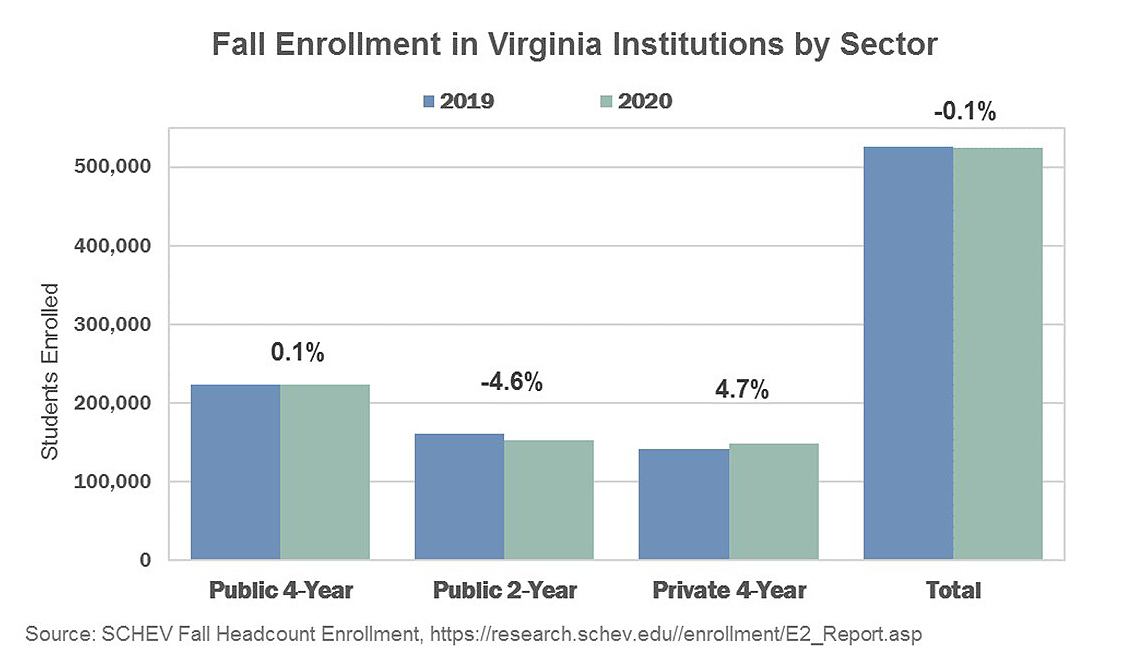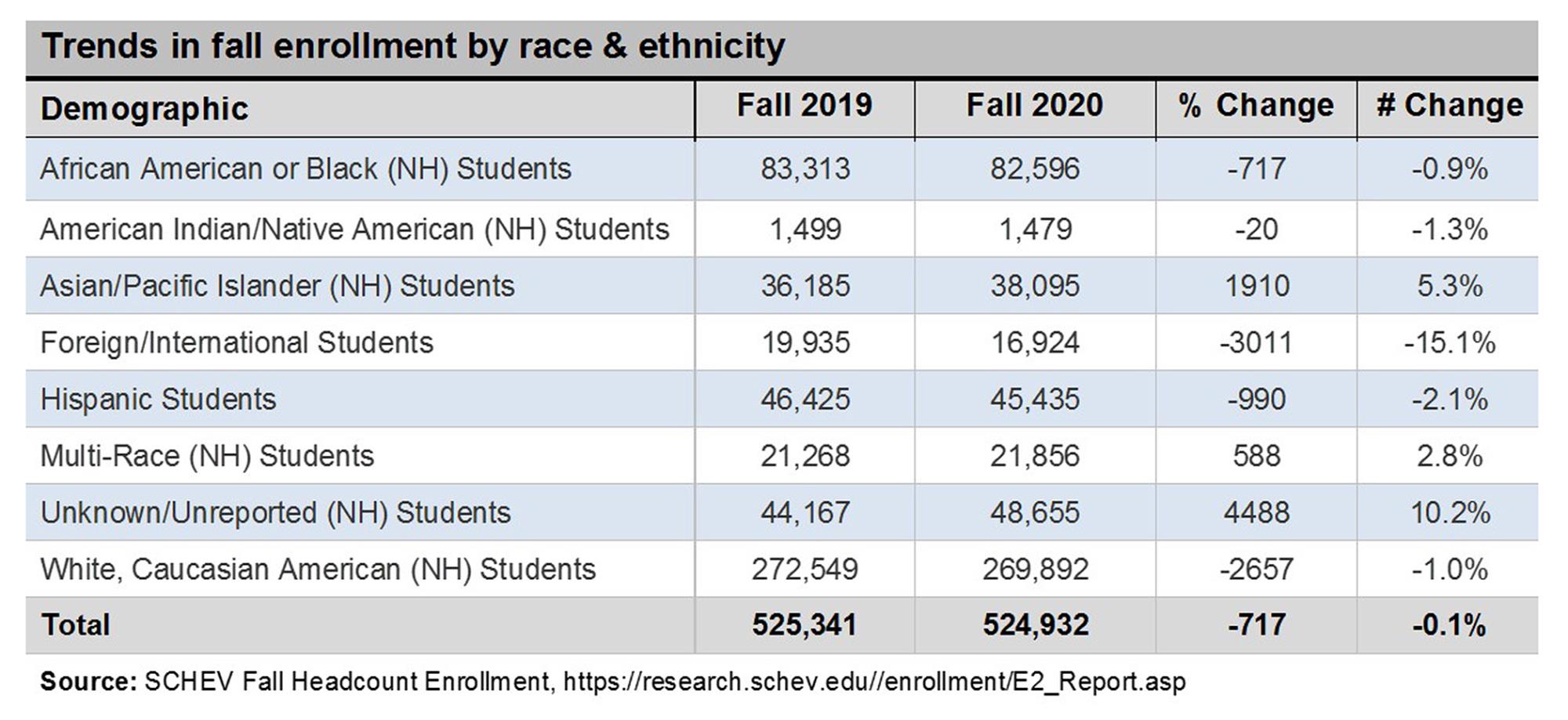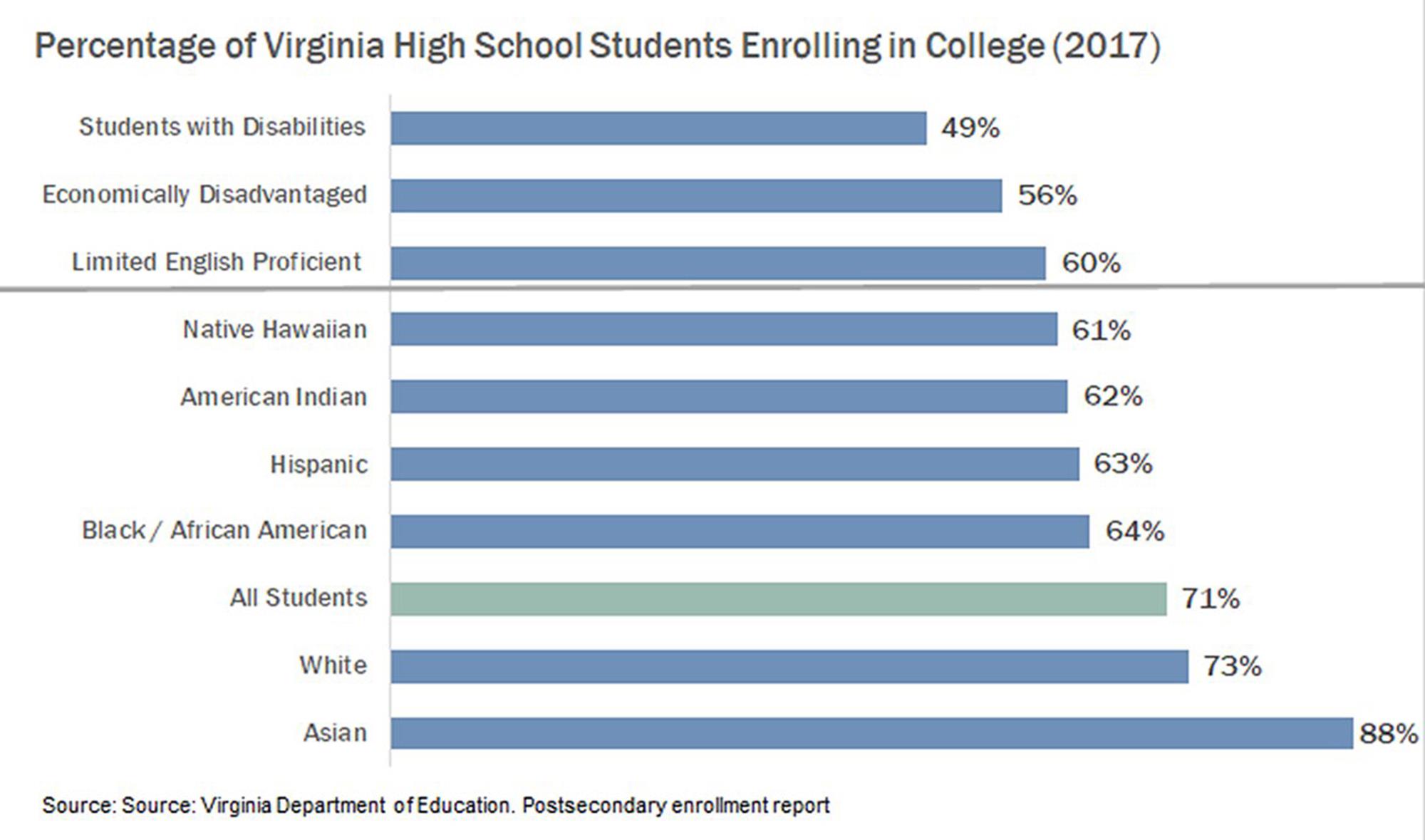(This Insight offers updates to the Early Enrollment Estimates published last fall with SCHEV’s final fall enrollment report.)
Enrollment at Virginia institutions of higher education remained at similar levels in Fall 2020 compared to the previous year, despite the COVID-19 pandemic that disrupted campus operations. This bucks nationwide trends, where enrollment decreased 2.5% according to the National Student Clearinghouse. While this relative stability is promising, there also are warning signs in SCHEV’s Fall 2020 enrollment data, which was recently made final. Fewer new students enrolled in college for the first time and in two-year programs. African American/Black and Hispanic student enrollment also declined, though comparable to white students. This Insight takes a deeper look at the data and makes specific comparisons, but readers are encouraged to make their own tables on SCHEV’s Research website.
Variations by Sector & Institution
Virginia’s community colleges saw steep declines of nearly 5% over 7,000 students. Its enrollment of 153,075 is the lowest since 2002. SCHEV’s strategic finance plan found that Virginia needs to award more sub-baccalaureate degrees and certificates to meet workforce demands, so it’s concerning to see the public two-year sector, the colleges that offer those programs, with the largest decrease. These counts only include students seeing for-credit degrees and certificates, and not the non-credited credentialing programs.
Overall, enrollment in the public four-year sector remained stable. Eight of Virginia's four-year public institutions lost students, however, the other seven grew their enrollment. George Mason University grew by the most students (777), while Radford University lost the most students (1,175). This decline at Radford was largely due to the wind down of a teacher competency-based education program, and not traditional undergraduates. The private four-year sector actually saw an increase of nearly 5%, although growth was largely attributed to out-of-state students attending Liberty University.
SCHEV’s Policy Analytics Unit analyzed these changes for statistical significance. While the changes at many institutions are within a reasonable distribution, other changes deviated significantly from the previously established trend.

New vs. Returning Students
New enrollment of first-time-in-college students (FTIC) declined nearly 8%, or over 6,000. This is concerning because fewer students today means fewer graduates in the future. This complicates Virginia’s efforts to be the best state for education in the nation with a 70% attainment rate by 2030 and could create financial challenges for institutions with fewer tuition-paying college students.
The number of younger students, students aged 24-years and under, also declined, while older students, aged 25 years and above, increased. This makes sense considering the trends in FTIC students.
Demographics
The new Virginia Plan for Higher Education prioritizes closing gaps in five main areas, including access, and SCHEV’s research website allows users to make comparisons between different types of groups. Demographically, there are also concerning trends. Looking statewide, there were fewer African American/Black and Hispanic students enrolled in Virginia institutions, and more Asian/Pacific Islander students in Fall 2020 compared to the year prior. The number of white students also declined. Not surprisingly, given restrictions on international travel, foreign/international students declined by over 3,000, or 15%.

Even before the pandemic, roughly 25,000 recent high school graduates don’t enroll in some sort of postsecondary program every year with wide disparities for non-white and low-income students. For instance, in 2017, 71% of students statewide enrolled in a postsecondary program, only 63% of Hispanic graduates, 64% of African American/Black graduates, and 56% of economically disadvantaged students do so. To see such a decline in enrollment among African American/Black and Hispanic students threatens to widen these gaps.
The declines in enrollment were also driven by gender; men’s enrollment dropped by nearly 4,000 students, or 2%, while women increased by over 3,000 students, or 1%. Women outnumbered men by over 80,000 students enrolled this past fall.

The Takeaway
All of the statistics in this report are descriptive, and don’t attempt to explain why some numbers are going up or down, but we can speculate two reasons: uncertainty and inequity. The pandemic, and the recession it triggered, disrupted many aspects of our lives. The uncertainty the pandemic sowed might have influenced some students to “hit pause” on starting any new academic plans; that’s why the levels of returning students remained stable and new students declined. We know the pandemic also exposed existing inequalities in our society and economy; professionals who could stay at home did not see any changes to their income, while households employed in the hospitality, food and other service industries lost jobs. This could explain the decline in institutions that serve these students, such as the community colleges.
There are also reasons to be optimistic. The budget coming out of the 2021 General Assembly session addresses some of these challenges. For instance, the budget funds a new statewide college access program, Guidance to Postsecondary Success (GPS). This program will develop resources and strategies to improve FAFSA completion rates and generally help prospective students navigate the college application process.
One of the most significant programs is the G3 program, which eliminates tuition and fees for low- and middle-income students enrolled in high-demand community college programs. The General Assembly also funded $5 million for promotion and to hire new counselors to help students find these programs. Hopefully this will address the declines in community college enrollment.
Welcome to Insights, SCHEV's platform to interpret and communicate data and policy with the overall goal of informing policy-making, engaging institutions and drawing attention to these resources. Centered around SCHEV's nationally leading data collection, each Insight will visualize complex ideas and help inform funding and policy decisions.
